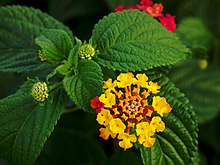
Back Lantana AF حشف (نبات) Arabic لانتانا ARZ Lantana AZ Лантана Bulgarian Lantana Catalan Kanding-kanding CEB Libora Czech Ildkrone Danish Wandelröschen (Gattung) German
This article needs additional citations for verification. (December 2007) |
| Lantana | |
|---|---|

| |
| Wild-type Spanish flag (Lantana camara) | |
| Scientific classification | |
| Kingdom: | Plantae |
| Clade: | Tracheophytes |
| Clade: | Angiosperms |
| Clade: | Eudicots |
| Clade: | Asterids |
| Order: | Lamiales |
| Family: | Verbenaceae |
| Genus: | Lantana L. |
| Type species | |
| Lantana camara | |

Lantana (/lænˈtɑːnə, -ˈteɪ-/)[2] is a genus of about 150 species of perennial flowering plants in the verbena family, Verbenaceae. They are native to tropical regions of the Americas and Africa but exist as an introduced species in numerous areas, especially in the Australian-Pacific region, South and Northeastern part of India. The genus includes both herbaceous plants and shrubs growing to 0.5–2 m (1.6–6.6 ft) tall. Their common names are shrub verbenas or lantanas. The generic name originated in Late Latin, where it refers to the unrelated Viburnum lantana.[3]
Lantana's aromatic flower clusters (called umbels) are a mix of red, orange, yellow, or blue and white florets. Other colors exist as new varieties are being selected. The flowers typically change color as they mature, resulting in inflorescences that are two- or three-colored.
"Wild lantanas" are plants of the unrelated genus Abronia, usually called "sand-verbenas".
- ^ "Lantana L." TROPICOS. Missouri Botanical Garden. Retrieved 2009-10-18.
- ^ "lantana". Lexico UK English Dictionary. Oxford University Press. Archived from the original on 2022-05-30.
- ^ Holloway, Joel Ellis; Neill, Amanda (2005). A Dictionary of Common Wildflowers of Texas & the Southern Great Plains. TCU Press. p. 88. ISBN 978-0-87565-309-9.